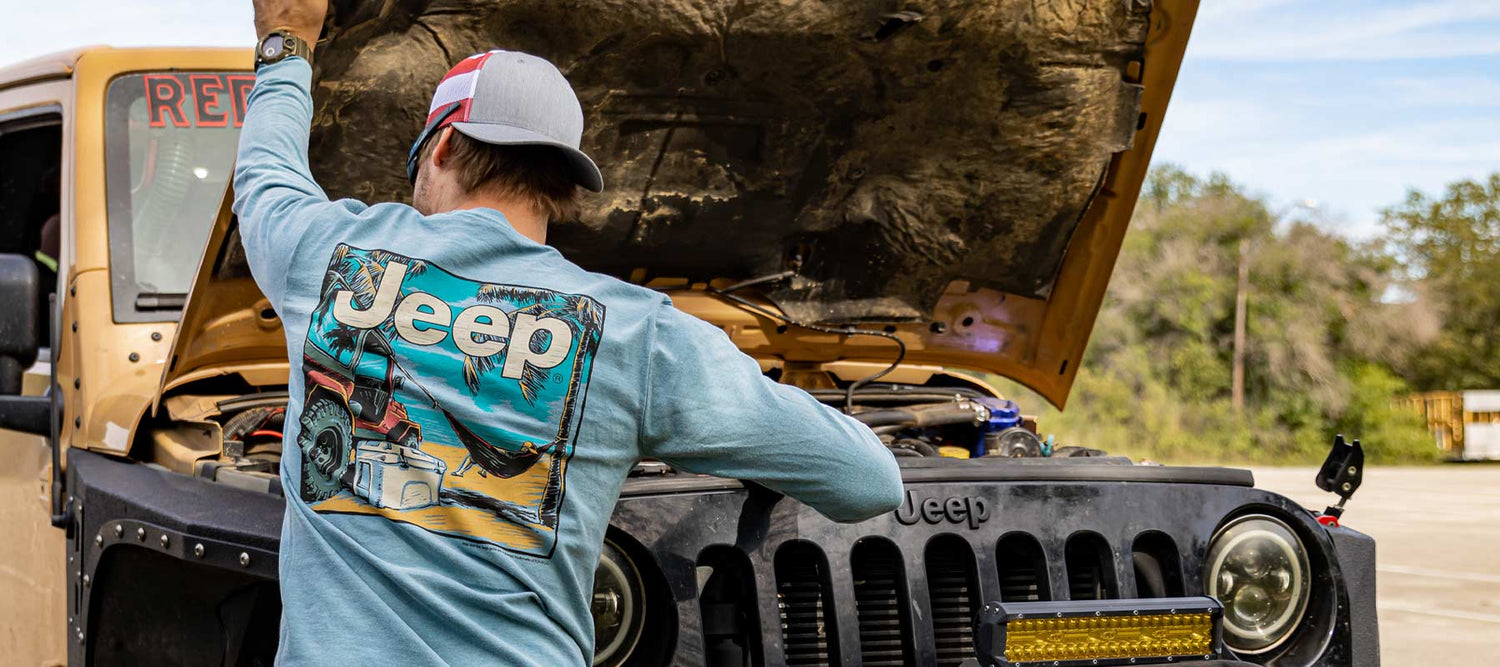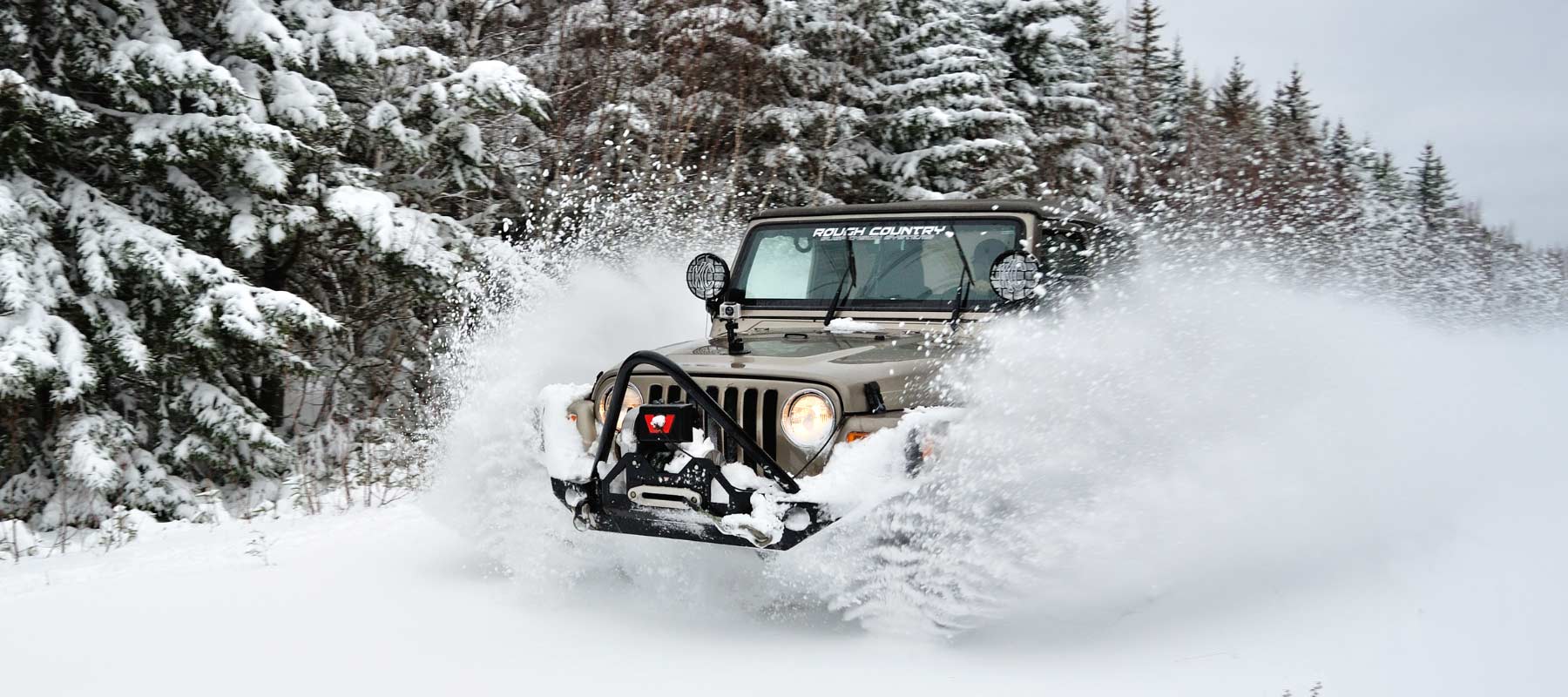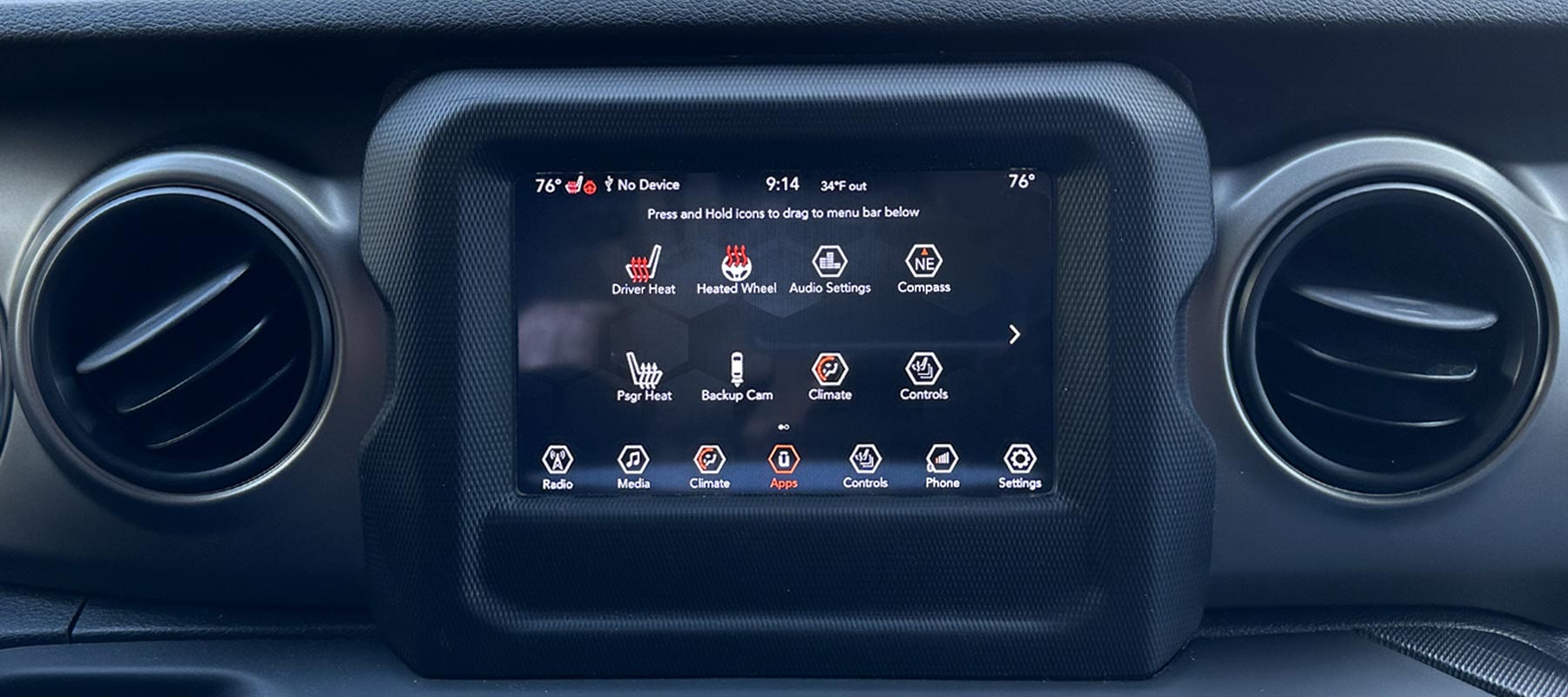Treat Your Ride with Post Off-Roading Jeep Maintenance
Your Jeep was built for off-roading fun. But to be able to continue hitting the trails, it’s important to take care of it after each trail ride. If you neglect your Jeep, it could show wear and tear sooner than you think. You could break down on the trail and ruin your next ride. Or worse, you could be the main character in someone else’s “Can you believe what happened to this poor Jeeper” story. If you give your Jeep the proper attention and keep it tight, you’ll be ready for the next adventure. Our Jeep maintenance tips will keep your Jeep running smoothly for many years and trails to come.
Clean Up Your Jeep

After all off-roading adventures, the first thing you should do is clean your Jeep. If your Jeep isn’t too dirty, you can run it through a car wash. Be sure to include an undercarriage wash to remove dirt from the bottom of your Jeep. If your vehicle is too dirty for a car wash, you’ll need to spray it off yourself. A manual car wash bay has the pressure washer with the right PSI to remove mud and dirt from your Jeep. Warm water is the best for removing mud, as the temperature loosens it enough to fall from the body of your vehicle.
When cleaning the soft top, use products like Raggtop, Mopar, and Bestop. These cleaners will help wash off the mud and contaminants without causing damage to your windows. Moreover, they don’t contain any oil, which can attract and retain dirt. But if you don’t have any of these specialty cleaners, vinegar and water or a mild dish detergent will do.
Don’t forget to clean the wheels and the fenders. Each time you go off-roading, mud and dirt collect in the wheels and can cause your Jeep to become unbalanced. Be sure you’ve removed all of the caked-on mud and dirt from your wheels. Cleaning your Jeep gives you more visibility and lets other off-roaders see you. Mud and dirt can have salt and other corrosive materials in them. If you let it build-up, it can cause your Jeep to rust, damaging its structural integrity and good looks. For more on cleaning up after mudding, click here.
Check and Adjust Your Tire Pressure

When Jeep owners go off-roading, many “air down,” reducing their tire pressure to get better traction on dirt roads. On moderate trails, drivers often reduce their air pressure by 25%. Rock crawlers reduce their tire PSI by 35% to get better traction on uneven rocks. And those driving on sand bring their tire pressure all the way down to 50% or less. But after off-roading, you don’t want to leave your tires like that. Leaving the PSI at low levels can damage your tires and your Jeep on paved roads. It can cause blowouts, reduce fuel economy, create tread tears, and diminish the life of your tire. So make sure to re-inflate those tires.
Perform a Differential and Transmission Check
Your Jeep has a differential that lets the wheels spin at different rates. The differential and the transmission use fluid to function properly. If you’ve driven in deep water or mud, the two components can become contaminated and damaged. The differential case can also be damaged if you hit a rock or other debris. When you’ve finished off-roading, take a moment to inspect your differential case for any sign of impairment. If you notice dents or cracks, the fluid inside could be compromised. Differential fluid should not be white. If this is the case, then you need new fluid.
It’s a good idea to check your transmission fluid. You can do this yourself, or take your Jeep to a dealership and ask for a quick check. Open the engine compartment and find the transmission fluid dipstick. Remove the stick, clean it off, then reinsert it fully and remove it again. Look at the stick to determine if your transmission fluid is full or low based on the markings. If your transmission fluid is low, your Jeep might struggle to change gears. You will lose fuel efficiency and potentially damage the transmission and engine.
Inspect Your Jeep Suspension System
Your Jeep’s suspension works hard on off-roading trips. After you’ve cleaned the undercarriage, it’s a good idea to inspect the suspension system. Jeep owners often crawl under their vehicles to look for loose or missing nuts and bolts. You can jiggle parts to determine if everything is still properly connected. You might look for rocks or debris stuck in tight spaces and fish them out before they become a problem.
Drivers also check control arms, springs, and track bars for damage and excessive wear. It’s also helpful to look at the steering box and shaft to be sure everything is still where it should be.
Checking your suspension can help you stay safe on all roads. When suspension components wear out, your Jeep’s ride can become compromised and you could end up in a ditch.
Put Grease Into Action
Excessive friction can be the death of vehicle components. After a rough off-road expedition, your Jeep will benefit from fresh grease, especially in greasable areas like u-joints, bearings, and driveshafts. Without the grease, friction can cause annoying squeaking sounds and (more importantly) damage that will require costly repairs. We recommend applying grease at least every oil change. It’s best to keep your Jeep lubed up and in proper working order for that next adventure.
Take A Closer Look At Your Air Filters
After cleaning your Jeep, check the filters. If they are clogged, replace them with new ones or clean them and reuse them. Engine and cabin air filters can become dirty from the dust and debris on off-road trails. That dirt can clog your engine and create unhealthy conditions in your passenger cabin. Clogged engine filters can cause engine damage and reduce your vehicle’s fuel efficiency. You should change your air filters every 15,000 to 30,000 miles under normal driving conditions, but off-roading is not a normal driving condition. Therefore, you’ll need to swap the air filters out or clean them a lot sooner.
Do A Thorough Frame Check
Finally, check your Jeep’s frame. Do a visual inspection of the joints, especially where you can see welds. Look for loose spots or other damage that could make your Jeep a danger on paved roads. If you see any problems, bring your Jeep to your dealership or body shop for repairs.
Conclusion
Maintaining your Jeep is the key to enjoyable and frequent off-roading trips. It also won’t hurt your Jeep’s resale value. So make sure you clean your Jeep after every run, and check tires, transmission, and other body components to make sure everything is properly connected and in good working order. If you aren’t mechanically inclined, your local dealership or off-road shop can help you with post-off-road maintenance tips. Most dealerships offer free multi-point inspections to check tire pressure, oil levels, and transmission fluids. Just keep your Jeep in prime condition so that it can do what it was meant to do: rip down the next off-roading trail.
Frequently Asked Questions
Curious about Jeep vehicles? Read on for commonly asked questions.
What Is the Jeep Wave?
The Jeep wave is a quick acknowledgment between Jeep drivers passing each other on the road. A Jeep Wave can be as simple as extending two or four fingers from the steering wheel and giving a nod. But you might also wave with your whole hand, especially if you’ve got your top down and doors off and want to raise your hand above the windshield or outside the body of the vehicle. Whatever your style, your fellow Jeep owners will appreciate the greeting. Hopefully, your wave will be returned.
The wave probably started in the 1960s and 70s, with the advent of off-roading culture. It was a way to salute another kindred spirit. In the early years, the Jeep wave was mainly the domain of CJ/YJ/TJ owners but has since expanded to any Jeep model, from off-roaders to daily drivers. Now that Jeeps have exploded in popularity, the Jeep wave is the preeminent automobile greeting, with fashionable gear to match.
The Jeep wave is so popular that Jeep named their loyalty program after the famous hand gesture. The Jeep Wave loyalty program provides benefits to new Jeep owners during the first three years of ownership. Jeep Wave members get free routine maintenance services (oil changes and tire rotations); trip-interruption coverage of up to $1,000 per occurrence; no-charge same day rental vehicles and vehicle delivery if your Jeep needs servicing or repair; and 24/7 roadside assistance and access to the Jeep elite customer service hotline.
Jeep Wave membership also removes the miles allowance from the factory warranty, so you can drive your Jeep as much as you want without losing vehicle protection coverage. Plus, you get VIP treatment at Jeep brand exclusive events and contests across the USA. You can also take advantage of discounts on hotel stays, restaurants, merchandise, and other deals from businesses participating in the Jeep Savings Network.
How Do You Maintain A Jeep?
Most Jeep models need oil changes and tire rotations every 7,500 miles. They also need new batteries, tires, and brakes on regular schedules. However, what will affect the timing of your maintenance most is the way you drive, the roads you frequent, and your off-roading habits. Keeping your Jeep running at its best includes keeping it clean, inspecting important components, and paying attention to fluid levels. With proper maintenance based on your owner’s manual, your Jeep can last for decades.
How Often Do Jeeps Need Oil Changes?
Most JK and JL models need oil changes between 5,000 and 7,500 miles. The older models need oil changes every 3,000 miles or once per season. When you bring your Jeep in for service at your local dealership, the service advisor can recommend the ideal timing based on your driving habits, the weather, and road conditions.
Vehicles often need more frequent oil changes if they’re driven in excessively hot or cold temperatures. Driving on hilly terrain can also increase the need for more frequent oil changes.
What Does A Duck Left On A Jeep Mean?
Jeep drivers have a game called “Duck, Duck, Jeep.” When a Jeeper sees another good-looking Jeep, they put a rubber duck on the fender or hood as a way to show respect. Hopefully, the recipient continues the game, by purchasing some rubber ducks and adorning other people’s Jeeps.
Some Jeep drivers add a note to the duck explaining the game, as some Jeep drivers are unaware of the significance of the rubber duck on their rides. Jeep drivers who receive a duck often keep it in their cabin on the dash for all to see. The only objective of ducking is to spread some kindness and make strangers smile. To take your ducking game to the next level, check out the Jeep Duck T-Shirt Collection.
Why Are There 7 Holes In A Jeep Grille?
The iconic Jeep grille has seven slots, surrounded by two round headlights. The original Jeep, however, had thirteen, and then the number dropped to nine and then seven. The seven-slot grille weighed less and was more affordable to produce than the original thirteen-slot grille. The seven-slot grille has been an iconic symbol of Jeep ever since.
American Bantam Car Company manufactured the first Jeep, but it worked with Ford and Willys to divide the lucrative contract with the Army. Eventually, Willy became the sole owner of the Jeep brand and the seven-slot grille.
What Kind Of Person Drives A Jeep Wrangler?
Jeep Wrangler drivers come in all shapes and sizes. They love the great outdoors and have a sense of adventure. They care about their communities and appreciate fine craftsmanship. They love to drive through rough terrain and go off-roading.
Wrangler drivers enjoy having a unique vehicle that offers flexible styling and off-road fun. Many also appreciate the versatility of the tops. Wrangler Unlimited is the only four-door convertible on the market today. People use their Jeep Wrangler models as daily drivers and off-road toys.
Many Jeep owners enjoy modifying their Jeeps, showing that they know how to work on their vehicles. However, other Jeep owners don’t mind driving a factory Jeep and never make any changes to their vehicles. Jeep owners have unique personalities, but they are united by their vehicle choice. Now that Jeep has an electric vehicle, the customer demographic is changing even more.
Today’s Wrangler owners have to be able to afford the high sticker price, and many owners come from families with household incomes over $120,000. Many Wrangler owners are also homeowners, and about 30% of all Jeep drivers are women. Jeep owners tend to be between the ages of 35 and 54, and many have children, who perhaps come along for off-road adventures.
How Often Do Jeeps Need Maintenance?
Jeep models need maintenance a few times each year. Your Jeep’s owner’s manual includes how often your vehicle needs oil changes, tire rotations, and other maintenance. Most models need oil changes every three months or between 5,000 and 7,500 miles. Jeeps benefit from a tire rotation and oil filter change at each oil change appointment at your local service center.
Your local Jeep dealership has service technicians who can perform engine coolant changes, tire rotations, and brake pad replacement service at recommended intervals. Sometimes, you'll need to bring your Jeep in when your brake linings start to wear or your parking brake starts to deteriorate. Your Jeep's maintenance schedule requires services at 7,500 and 15,000-mile intervals. Many service departments provide multi-point inspections to help owners understand what maintenance service needs are on the horizon.







